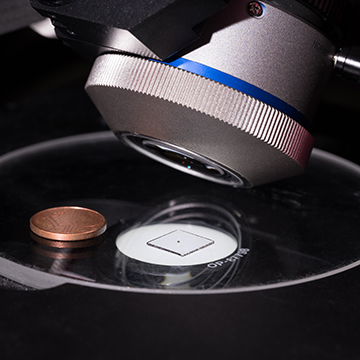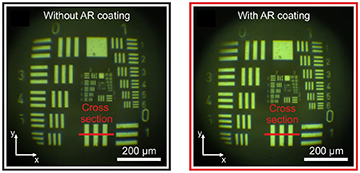A 600-µm-diameter doublet lens system, 3D-printed on a 1×1 cm² glass slide, beneath a tilted microscope objective. The doublet lens system is visible as the small dot in the center of the glass slide. The coin is included for scale. [Image: M. Flöss, University of Stuttgart] [Enlarge image]
To boost light transmission and reduce reflection, manufacturers often coat lenses before assembling them into devices such as cameras. However, coating 3D-printed lenses—especially ones less than 1 mm thick—can be quite difficult. This is because creating an optical system via 3D printing is often a single-step process, which produces nooks and crannies between individual lenses that cannot be accessed using conventional coating techniques.
Now, three researchers in Germany have developed a way to apply antireflective (AR) coatings to 3D-printed multi-lens systems (Opt. Mater. Express, doi: 10.1364/OME.454475). To do so, they’ve used atomic layer deposition (ALD) at a relatively low temperature, which evades thermal damage on the lenses.
“Our new method will benefit any 3D-printed complex optical system that uses multiple lenses,” said Harald Giessen at the University of Stuttgart in Germany in a press release. “However, it is especially useful for applications such as miniature fiber endoscopes, which require high-quality optics and are used for imaging under less-than-ideal lighting conditions.”
Evading thermal damage
3D printing has revolutionized a wide range of fields, including optics and photonics. Fabricating optics via 3D printing has enable creation of freeform surfaces such as aspheric lenses. And 3D printing of optical systems—especially sub-millimeter-sized micro-optics—has allowed manufacturers to create a perfectly aligned multi-lens system in a single-step process, eliminating the need to assemble parts manufactured separately.
However, when it comes to applying AR coating—which both reduces losses due to reflection and prevents the formation of quality-sapping “ghost” images—conventional methods such as sputtering or directed-plasma etching do not work on 3D-printed optical systems. That’s because the single-step manufacturing process of 3D printing creates tiny gaps between the individual lenses that cannot be reached by a directed coating beam.
To solve this issue, the Stuttgart team decided to use ALD at an operating temperature around 150 °C. The team chose that temperature to avoid thermal damage to the lenses, as the typical glass-transition temperature of the polymeric lens material used in 3D printing is around 200 °C.
For their AR coating, the researchers used ALD to deposit four alternating layers of titanium dioxide and silica with varying thicknesses—17 nm TiO2, 44 nm SiO2, 27 nm TiO2 and 109 nm SiO2—carefully calculated to minimize reflections. The deposition process first starts with precursor molecules containing silicon or titanium. The researchers then introduce ozone molecules to replace the organic parts of the precursor molecules with oxygen. Finally, after purging the reaction byproducts, a single layer of TiO2 or SiO2 forms on the lens surface. Because the resulting layer’s thickness is around 0.1 nm, the researchers repeated the process until the layer arrived at their desired thickness.
More light transmission with coatings
After confirming that they successfully applied AR coatings to 3D-printed structures, the researchers quantitatively characterized their ALD coatings. They coated one or both sides of flat, glass substrates sized 1×1 cm2, and compared them with an uncoated one. The researchers found that with both sides coated, the reflectivity of the glass substrate fell below 1% for light between 450 and 680 nm, versus around 8% in uncoated substrate.
USAF 1951 resolution test target imaged by an uncoated (left) and an AR-coated (right) double-lens imaging system. [Image: S. Ristok et al., Opt. Mater. Express 12, 2063 (2022), doi: 10.1364/OME.454475] [Enlarge image]
The researchers also demonstrated the new coating technique with a 3D-printed double-lens imaging system that was about 600 µm wide. When tested, the coated system transmitted about 20% more white-LED light than the uncoated system.
The researchers write that, in addition to providing the optical antireflective properties, the coatings will increase the physical and chemical durability of 3D-printed optics. In the future, they plan to apply their coating technique to more complex optical systems with more than two lenses. They also hope to increase the number of coating layers, which will result in even lower reflection losses for certain wavelengths.
Finally, the researchers are looking to collaborate with others who are interested in incorporating AR coatings into their 3D-printed optical systems, according to the press release.


